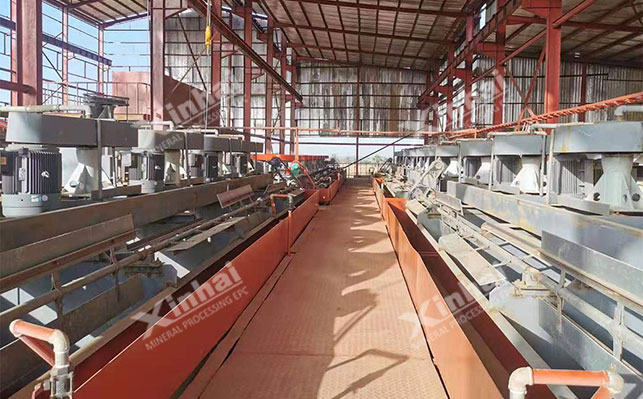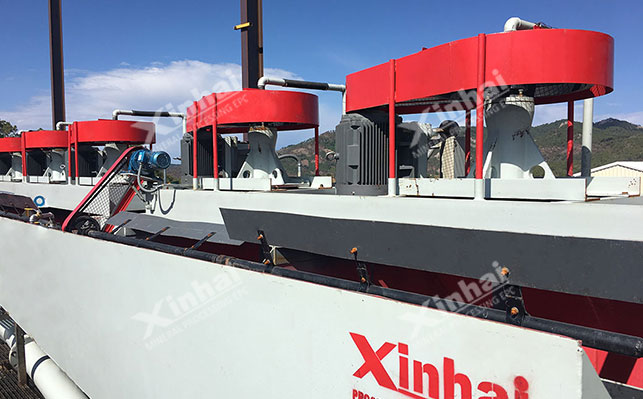If you want to know more information (such as product/process price, etc.), please contact us 24-hour telephone
Amid the rapid growth of the new energy industry, the efficient separation and resource utilization of polymetallic spodumene ores have become a global technical frontier in mineral resource development. This article systematically analyzes key technological pathways for spodumene flotation separation in complex symbiotic systems, integrating mineral interface chemistry regulation theory and industrial practice data to enhance comprehensive resource utilization efficiency.

1.1 Optimized Positive Flotation Process
(1)Technical features:
Uses phosphate inhibitors (Na₂SiO₃:Na₂CO₃=3:1) to selectively suppress feldspar/quartz.
Employs carboxylic acid collectors (oleic acid, 0.8–1.2 kg/t) for preferential spodumene enrichment.
(2)Applications:
Achieves Li₂O concentrate grades of 6.2–6.8% when spodumene's embedded grain size exceeds 0.15 mm and contact angle differences with gangue minerals exceed 15°56.
1.2 Innovative Reverse Flotation Process
(1)Activation control:
HF acid washing (0.3–0.5 kg/t) activates Al³+ sites on feldspar surfaces.
Amine collectors (dodecylamine, 0.4–0.6 kg/t) efficiently remove gangue minerals.
(2)Advantages:
Boosts spodumene recovery by 12–15% in fine-grained ores (-0.074 mm fraction ≥75%)13.
1.3 Combined Flotation Synergy
(1)Process design:
Positive flotation rougher (pH=6.5–7.0) → Reverse flotation cleaner (pH=2.5–3.0) → Magnetic iron removal (1.2 T field).
(2)Industrial case:
A polymetallic ore (Li₂O 1.2%, Fe₂O₃ 8.3%) achieved 89% Li₂O recovery using this circuit47.

| Reagent Type | Mechanism | Innovative Variants | Performance |
|---|---|---|---|
| Composite Collectors | Synergistic hydrophobic adsorption | Oleic acid-hydroxamic acid (3:1) | Selectivity ↑23% |
| Novel Depressants | Block Al-O active sites | Modified calcium lignosulfonate | Gangue suppression >85% |
| pH-Responsive Activators | Smart surface potential regulation | Amphoteric polymer AMP-7 | Pulp stability ↑40% |
3.1 Stage Liberation-Asynchronous Flotation
Coarse grinding (-0.3 mm): Pre-discards 30–35% low-grade material.
Regrinding (-0.074 mm ≥90%): Vertical mills reduce specific energy consumption by 25%.
Flotation configuration: Rougher (3 cells) → Cleaner (5 stages) → Scavenger (2 stages) closed circuit.
3.2 Flow Field Enhancement Equipment
Aerated flotation columns: Microbubble generators (0.1–0.3 mm diameter) improve collision probability.
Smart dosing systems: Machine vision-based online grade analysis dynamically adjusts reagent regimes.
4.1 Associated Element Recovery
(1)Tantalum-niobium recovery:
Combined high-intensity magnetic separation (1.8 T) + gravity (shaking table) → Ta₂O₅ grade: 35%.
(2)Feldspar Recovery:
Acid washing (15% H₂SO₄) + calcination (850°C) converts tailings into ceramic raw materials.
(3)Mica Recovery:
High-voltage electrostatic separation (50 kV) yields premium mica (K₂O >9%).
4.2 Water Circulation System
Recycling rate: >85% via ozone oxidation (5 mg/L) for residual reagent degradation.
Thickener overflow: COD <80 mg/L, meeting discharge standards.
Conclusion
As a full-cycle mineral resource solutions provider, our company delivers an integrated system encompassing mineral genetic testing, process simulation, intelligent control, and tailings valorization. Leveraging the proprietary FloSim 3.0 flotation dynamics simulation platform, we help clients reduce process commissioning time by 60% and increase resource revenue by 35%. Submit ore samples via our online laboratory for customized technical solutions.